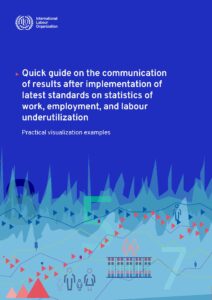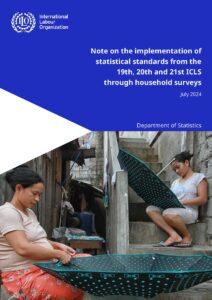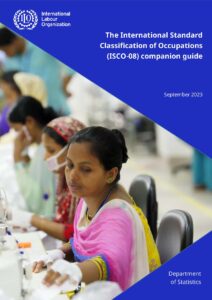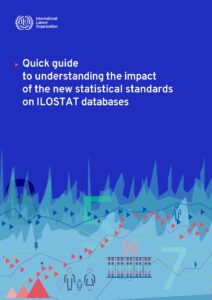Table of Contents
Related pages
Introduction
The importance of employment as a pathway to economic development, social inclusion and well-being has long been recognised. As well as being at the heart of the ILO’s Decent Work Agenda, employment is a central element in the 2030 Agenda for Sustainable Development which places emphasis on promoting productive employment and decent work for all (Goal 8).
In this context, statistics on employment are crucial to monitor progress towards many national and international policy goals. These statistics must not just quantify work and people in employment but also provide meaningful information on the types of jobs people are doing.
The international statistical standards relating to employment have undergone significant changes over time, designed to improve their relevance and depth for policy makers. The most significant of these changes came at the 19th International Conference of Labour Statisticians in 2013 when the international community adopted the first statistical definition of work alongside a forms of work framework. Within the new framework, employment is defined as work performed in return for pay or profit. This is narrower than the scope of the previous definition which included some unpaid activities such as subsistence work.
Data catalogue
| Indicator | Frequency | Database | Subject | Download (with labels) | Download (with codes) | Data explorer |
|---|---|---|---|---|---|---|
| SDG indicator 5.5.2 - Proportion of women in senior and middle management positions (%) | Annual | SDG Labour Market Indicators (ILOSDG) | Employment | .csv .dta .xlsx | .csv.gz | |
| SDG indicator 5.5.2 - Proportion of women in managerial positions (%) | Annual | SDG Labour Market Indicators (ILOSDG) | Employment | .csv .dta .xlsx | .csv.gz | |
| SDG indicator 9.2.2 - Manufacturing employment as a proportion of total employment (%) | Annual | SDG Labour Market Indicators (ILOSDG) | Employment | .csv .dta .xlsx | .csv.gz | |
| Employment by sex and age (thousands) | Annual | Labour Force Statistics (LFS) | Employment | .csv .dta .xlsx | .csv.gz | |
| Employment by sex and age (thousands) | Quarterly | Short-Term Labour Force Statistics (STLFS) | Employment | .csv .dta .xlsx | .csv.gz | |
| Employment by sex and age (thousands) | Monthly | Short-Term Labour Force Statistics (STLFS) | Employment | .csv .dta .xlsx | .csv.gz | |
| Employment by sex, age and education (thousands) | Annual | Education and Mismatch Indicators (EMI) | Employment | .csv .dta | .csv.gz | |
| Employment by sex, age and education (thousands) | Quarterly | Short-Term Labour Force Statistics (STLFS) | Employment | .csv .dta | .csv.gz | |
| Employment by sex, age and education (thousands) | Monthly | Short-Term Labour Force Statistics (STLFS) | Employment | .csv .dta .xlsx | .csv.gz | |
| Employment by sex, age and rural / urban areas (thousands) | Annual | Rural and Urban Labour Markets (RURBAN) | Employment | .csv .dta .xlsx | .csv.gz | |
| Employment by sex, age and rural / urban areas (thousands) | Quarterly | Short-Term Labour Force Statistics (STLFS) | Employment | .csv .dta .xlsx | .csv.gz | |
| Employment by sex, age and rural / urban areas (thousands) | Monthly | Short-Term Labour Force Statistics (STLFS) | Employment | .csv .dta .xlsx | .csv.gz | |
| Employment by sex, age and marital status (thousands) | Annual | Gender Equality and Non-Discrimination Indicators (GEND) | Employment | .csv .dta .xlsx | .csv.gz | |
| Employment by sex, age and marital status (thousands) | Quarterly | Short-Term Labour Force Statistics (STLFS) | Employment | .csv .dta | .csv.gz | |
| Employment by sex, age and disability status (thousands) | Annual | Disability Labour Market Indicators (DLMI) | Employment | .csv .dta .xlsx | .csv.gz | |
| Employment by sex, age and status in employment (thousands) | Annual | Labour Force Statistics (LFS) | Employment | .csv .dta .xlsx | .csv.gz | |
| Employment by sex, age and status in employment (thousands) | Quarterly | Short-Term Labour Force Statistics (STLFS) | Employment | .csv .dta | .csv.gz | |
| Employment by sex, age and economic activity (thousands) | Annual | Labour Force Statistics (LFS) | Employment | .csv .dta | .csv.gz | |
| Employment by sex, age and economic activity (thousands) | Quarterly | Short-Term Labour Force Statistics (STLFS) | Employment | .csv .dta | .csv.gz | |
| Employment by sex, age and occupation (thousands) | Annual | Labour Force Statistics (LFS) | Employment | .csv .dta | .csv.gz | |
| Employment by sex, age and occupation (thousands) | Quarterly | Short-Term Labour Force Statistics (STLFS) | Employment | .csv .dta | .csv.gz | |
| Employment by sex, age and public/private sector (thousands) | Annual | Labour Force Statistics (LFS) | Employment | .csv .dta .xlsx | .csv.gz | |
| Employment by sex, age and public/private sector (thousands) | Quarterly | Short-Term Labour Force Statistics (STLFS) | Employment | .csv .dta .xlsx | .csv.gz | |
| Employment by sex, age and working time arrangement (thousands) | Annual | Wages and Working Time Statistics (COND) | Employment | .csv .dta .xlsx | .csv.gz | |
| Employment by sex, age and working time arrangement (thousands) | Quarterly | Short-Term Labour Force Statistics (STLFS) | Employment | .csv .dta | .csv.gz | |
| Employment by sex, age and working time arrangement (thousands) | Monthly | Short-Term Labour Force Statistics (STLFS) | Employment | .csv .dta .xlsx | .csv.gz | |
| Employment by sex and education (thousands) | Annual | Education and Mismatch Indicators (EMI) | Employment | .csv .dta .xlsx | .csv.gz | |
| Employment by sex and education (thousands) | Quarterly | Short-Term Labour Force Statistics (STLFS) | Employment | .csv .dta .xlsx | .csv.gz | |
| Employment by sex and education (thousands) | Monthly | Short-Term Labour Force Statistics (STLFS) | Employment | .csv .dta .xlsx | .csv.gz | |
| Employment by sex, education and rural / urban areas (thousands) | Annual | Education and Mismatch Indicators (EMI) | Employment | .csv .dta .xlsx | .csv.gz | |
| Employment by sex, education and rural / urban areas (thousands) | Quarterly | Short-Term Labour Force Statistics (STLFS) | Employment | .csv .dta .xlsx | .csv.gz | |
| Employment by sex, education and marital status (thousands) | Annual | Education and Mismatch Indicators (EMI) | Employment | .csv .dta .xlsx | .csv.gz | |
| Employment by sex, education and disability status (thousands) | Annual | Disability Labour Market Indicators (DLMI) | Employment | .csv .dta .xlsx | .csv.gz | |
| Employment by sex and rural / urban areas (thousands) | Annual | Rural and Urban Labour Markets (RURBAN) | Employment | .csv .dta .xlsx | .csv.gz | |
| Employment by sex and rural / urban areas (thousands) | Quarterly | Short-Term Labour Force Statistics (STLFS) | Employment | .csv .dta .xlsx | .csv.gz | |
| Employment by sex and rural / urban areas (thousands) | Monthly | Short-Term Labour Force Statistics (STLFS) | Employment | .csv .dta .xlsx | .csv.gz | |
| Employment by sex, rural / urban area and marital status (thousands) | Annual | Rural and Urban Labour Markets (RURBAN) | Employment | .csv .dta .xlsx | .csv.gz | |
| Employment by sex, rural / urban area and marital status (thousands) | Quarterly | Short-Term Labour Force Statistics (STLFS) | Employment | .csv .dta .xlsx | .csv.gz | |
| Employment by sex, rural / urban areas and disability status (thousands) | Annual | Disability Labour Market Indicators (DLMI) | Employment | .csv .dta .xlsx | .csv.gz | |
| Employment by sex, rural / urban areas and disability status (thousands) | Quarterly | Short-Term Labour Force Statistics (STLFS) | Employment | .csv .dta .xlsx | .csv.gz | |
| Employment by sex and marital status (thousands) | Annual | Gender Equality and Non-Discrimination Indicators (GEND) | Employment | .csv .dta .xlsx | .csv.gz | |
| Employment by sex and marital status (thousands) | Quarterly | Short-Term Labour Force Statistics (STLFS) | Employment | .csv .dta .xlsx | .csv.gz | |
| Employment by sex and marital status (thousands) | Monthly | Short-Term Labour Force Statistics (STLFS) | Employment | .csv .dta .xlsx | .csv.gz | |
| Employment by sex, marital status and disability status (thousands) | Annual | Disability Labour Market Indicators (DLMI) | Employment | .csv .dta .xlsx | .csv.gz | |
| Employment by sex, marital status and disability status (thousands) | Quarterly | Short-Term Labour Force Statistics (STLFS) | Employment | .csv .dta .xlsx | .csv.gz | |
| Employment by sex and disability status (thousands) | Annual | Disability Labour Market Indicators (DLMI) | Employment | .csv .dta .xlsx | .csv.gz | |
| Employment by sex and status in employment (thousands) | Annual | Labour Force Statistics (LFS) | Employment | .csv .dta .xlsx | .csv.gz | |
| Employment by sex and status in employment (thousands) | Quarterly | Short-Term Labour Force Statistics (STLFS) | Employment | .csv .dta .xlsx | .csv.gz | |
| Employment by sex and status in employment (thousands) | Monthly | Short-Term Labour Force Statistics (STLFS) | Employment | .csv .dta .xlsx | .csv.gz | |
| Employment by sex, status in employment and education (thousands) | Annual | Education and Mismatch Indicators (EMI) | Employment | .csv .dta .xlsx | .csv.gz | |
| Employment by sex, status in employment and rural / urban areas (thousands) | Annual | Rural and Urban Labour Markets (RURBAN) | Employment | .csv .dta .xlsx | .csv.gz | |
| Employment by sex, status in employment and marital status (thousands) | Annual | Gender Equality and Non-Discrimination Indicators (GEND) | Employment | .csv .dta .xlsx | .csv.gz | |
| Employment by sex, status in employment and marital status (thousands) | Quarterly | Short-Term Labour Force Statistics (STLFS) | Employment | .csv .dta .xlsx | .csv.gz | |
| Employment by sex, status in employment and disability status (thousands) | Annual | Disability Labour Market Indicators (DLMI) | Employment | .csv .dta .xlsx | .csv.gz | |
| Employment by sex, status in employment and economic activity (thousands) | Annual | Labour Force Statistics (LFS) | Employment | .csv .dta | .csv.gz | |
| Employment by sex, status in employment and economic activity (thousands) | Quarterly | Short-Term Labour Force Statistics (STLFS) | Employment | .csv .dta | .csv.gz | |
| Employment by sex, status in employment and occupation (thousands) | Annual | Labour Force Statistics (LFS) | Employment | .csv .dta | .csv.gz | |
| Employment by sex, status in employment and occupation (thousands) | Quarterly | Short-Term Labour Force Statistics (STLFS) | Employment | .csv .dta | .csv.gz | |
| Employment by sex, status in employment and public/private sector (thousands) | Annual | Labour Force Statistics (LFS) | Employment | .csv .dta .xlsx | .csv.gz | |
| Employment by sex, status in employment and public/private sector (thousands) | Quarterly | Short-Term Labour Force Statistics (STLFS) | Employment | .csv .dta .xlsx | .csv.gz | |
| Employment by sex, status in employment and establishment size (thousands) | Annual | Labour Force Statistics (LFS) | Employment | .csv .dta .xlsx | .csv.gz | |
| Employment by sex, status in employment and establishment size (thousands) | Quarterly | Short-Term Labour Force Statistics (STLFS) | Employment | .csv .dta .xlsx | .csv.gz | |
| Employment by sex, status in employment and multiple job holding (thousands) | Annual | Labour Force Statistics (LFS) | Employment | .csv .dta .xlsx | .csv.gz | |
| Employment by sex and economic activity (thousands) | Annual | Labour Force Statistics (LFS) | Employment | .csv .dta .xlsx | .csv.gz | |
| Employment by sex and economic activity (thousands) | Quarterly | Short-Term Labour Force Statistics (STLFS) | Employment | .csv .dta .xlsx | .csv.gz | |
| Employment by sex and economic activity (thousands) | Monthly | Short-Term Labour Force Statistics (STLFS) | Employment | .csv .dta .xlsx | .csv.gz | |
| Employment by sex, economic activity and education (thousands) | Annual | Education and Mismatch Indicators (EMI) | Employment | .csv .dta | .csv.gz | |
| Employment by sex, economic activity and education (thousands) | Quarterly | Short-Term Labour Force Statistics (STLFS) | Employment | .csv .dta | .csv.gz | |
| Employment by sex, economic activity and rural / urban areas (thousands) | Annual | Rural and Urban Labour Markets (RURBAN) | Employment | .csv .dta .xlsx | .csv.gz | |
| Employment by sex, economic activity and marital status (thousands) | Annual | Gender Equality and Non-Discrimination Indicators (GEND) | Employment | .csv .dta .xlsx | .csv.gz | |
| Employment by sex, economic activity and marital status (thousands) | Quarterly | Short-Term Labour Force Statistics (STLFS) | Employment | .csv .dta .xlsx | .csv.gz | |
| Employment by sex, economic activity and disability status (thousands) | Annual | Disability Labour Market Indicators (DLMI) | Employment | .csv .dta .xlsx | .csv.gz | |
| Employment by economic activity and occupation (thousands) | Annual | Labour Force Statistics (LFS) | Employment | .csv .dta | .csv.gz | |
| Employment by economic activity and occupation (thousands) | Quarterly | Short-Term Labour Force Statistics (STLFS) | Employment | .csv .dta | .csv.gz | |
| Employment by sex, economic activity and public/private sector (thousands) | Annual | Labour Force Statistics (LFS) | Employment | .csv .dta .xlsx | .csv.gz | |
| Employment by sex, economic activity and public/private sector (thousands) | Quarterly | Short-Term Labour Force Statistics (STLFS) | Employment | .csv .dta .xlsx | .csv.gz | |
| Employment by sex, economic activity and public/private sector (thousands) | Monthly | Short-Term Labour Force Statistics (STLFS) | Employment | .csv .dta .xlsx | .csv.gz | |
| Employment by sex, economic activity and establishment size (thousands) | Annual | Labour Force Statistics (LFS) | Employment | .csv .dta .xlsx | .csv.gz | |
| Employment by sex, economic activity and establishment size (thousands) | Quarterly | Short-Term Labour Force Statistics (STLFS) | Employment | .csv .dta .xlsx | .csv.gz | |
| Employment by sex and economic activity - ISIC level 2 (thousands) | Annual | Labour Force Statistics (LFS) | Employment | .csv .dta .xlsx | .csv.gz | |
| Employment by sex, economic activity and multiple job holding (thousands) | Annual | Labour Force Statistics (LFS) | Employment | .csv .dta .xlsx | .csv.gz | |
| Employment by sex, economic activity and multiple job holding (thousands) | Quarterly | Short-Term Labour Force Statistics (STLFS) | Employment | .csv .dta .xlsx | .csv.gz | |
| Employment by age and economic activity - ISIC level 2 (thousands) | Annual | Labour Force Statistics (LFS) | Employment | .csv .dta .xlsx | .csv.gz | |
| Employment by sex, education and economic activity - ISIC level 2 (thousands) | Annual | Education and Mismatch Indicators (EMI) | Employment | .csv .dta | .csv.gz | |
| Employment by sex, status in employment and economic activity - ISIC level 2 (thousands) | Annual | Labour Force Statistics (LFS) | Employment | .csv .dta | .csv.gz | |
| Employment by sex, occupation and economic activity - ISIC level 2 (thousands) | Annual | Labour Force Statistics (LFS) | Employment | .csv .dta | .csv.gz | |
| Employment by sex, establishment size and economic activity - ISIC level 2 (thousands) | Annual | Labour Force Statistics (LFS) | Employment | .csv .dta .xlsx | .csv.gz | |
| Employment by sex and occupation (thousands) | Annual | Labour Force Statistics (LFS) | Employment | .csv .dta .xlsx | .csv.gz | |
| Employment by sex and occupation (thousands) | Quarterly | Short-Term Labour Force Statistics (STLFS) | Employment | .csv .dta .xlsx | .csv.gz | |
| Employment by sex and occupation (thousands) | Monthly | Short-Term Labour Force Statistics (STLFS) | Employment | .csv .dta .xlsx | .csv.gz | |
| Employment by sex, occupation and education (thousands) | Annual | Education and Mismatch Indicators (EMI) | Employment | .csv .dta | .csv.gz | |
| Employment by sex, occupation and education (thousands) | Quarterly | Short-Term Labour Force Statistics (STLFS) | Employment | .csv .dta | .csv.gz | |
| Employment by sex, occupation and rural / urban areas (thousands) | Annual | Rural and Urban Labour Markets (RURBAN) | Employment | .csv .dta .xlsx | .csv.gz | |
| Employment by sex, occupation and marital status (thousands) | Annual | Gender Equality and Non-Discrimination Indicators (GEND) | Employment | .csv .dta .xlsx | .csv.gz | |
| Employment by sex, occupation and marital status (thousands) | Quarterly | Short-Term Labour Force Statistics (STLFS) | Employment | .csv .dta .xlsx | .csv.gz | |
| Employment by sex, occupation and disability status (thousands) | Annual | Disability Labour Market Indicators (DLMI) | Employment | .csv .dta .xlsx | .csv.gz | |
| Employment by sex, occupation and public/private sector (thousands) | Annual | Labour Force Statistics (LFS) | Employment | .csv .dta .xlsx | .csv.gz | |
| Employment by sex, occupation and public/private sector (thousands) | Quarterly | Short-Term Labour Force Statistics (STLFS) | Employment | .csv .dta .xlsx | .csv.gz | |
| Employment by sex, occupation and establishment size (thousands) | Annual | Labour Force Statistics (LFS) | Employment | .csv .dta .xlsx | .csv.gz | |
| Employment by sex, occupation and establishment size (thousands) | Quarterly | Short-Term Labour Force Statistics (STLFS) | Employment | .csv .dta .xlsx | .csv.gz | |
| Employment by sex, occupation and multiple job holding (thousands) | Annual | Labour Force Statistics (LFS) | Employment | .csv .dta .xlsx | .csv.gz | |
| Employment by sex, occupation and multiple job holding (thousands) | Quarterly | Short-Term Labour Force Statistics (STLFS) | Employment | .csv .dta .xlsx | .csv.gz | |
| Employment by sex and occupation - ISCO level 2 (thousands) | Annual | Labour Force Statistics (LFS) | Employment | .csv .dta .xlsx | .csv.gz | |
| Employment by age and occupation - ISCO level 2 (thousands) | Annual | Labour Force Statistics (LFS) | Employment | .csv .dta .xlsx | .csv.gz | |
| Employment by sex and public/private sector (thousands) | Annual | Labour Force Statistics (LFS) | Employment | .csv .dta .xlsx | .csv.gz | |
| Employment by sex and public/private sector (thousands) | Quarterly | Short-Term Labour Force Statistics (STLFS) | Employment | .csv .dta .xlsx | .csv.gz | |
| Employment by sex, public/private sector and rural/urban areas (thousands) | Annual | Rural and Urban Labour Markets (RURBAN) | Employment | .csv .dta .xlsx | .csv.gz | |
| Employment by sex, public/private sector and rural/urban areas (thousands) | Quarterly | Short-Term Labour Force Statistics (STLFS) | Employment | .csv .dta .xlsx | .csv.gz | |
| Employment by sex, public/private sector and marital status (thousands) | Annual | Gender Equality and Non-Discrimination Indicators (GEND) | Employment | .csv .dta .xlsx | .csv.gz | |
| Employment by sex, public/private sector and marital status (thousands) | Quarterly | Short-Term Labour Force Statistics (STLFS) | Employment | .csv .dta .xlsx | .csv.gz | |
| Employment by sex, public/private sector and disability status (thousands) | Annual | Disability Labour Market Indicators (DLMI) | Employment | .csv .dta .xlsx | .csv.gz | |
| Employment by sex, public/private sector and disability status (thousands) | Quarterly | Short-Term Labour Force Statistics (STLFS) | Employment | .csv .dta .xlsx | .csv.gz | |
| Employment by sex and establishment size (thousands) | Annual | Labour Force Statistics (LFS) | Employment | .csv .dta .xlsx | .csv.gz | |
| Employment by sex and establishment size (thousands) | Quarterly | Short-Term Labour Force Statistics (STLFS) | Employment | .csv .dta .xlsx | .csv.gz | |
| Employment by sex and establishment size (thousands) | Monthly | Short-Term Labour Force Statistics (STLFS) | Employment | .csv .dta .xlsx | .csv.gz | |
| Employment by sex, establishment size and rural / urban areas (thousands) | Annual | Rural and Urban Labour Markets (RURBAN) | Employment | .csv .dta .xlsx | .csv.gz | |
| Employment by sex, establishment size and rural / urban areas (thousands) | Quarterly | Short-Term Labour Force Statistics (STLFS) | Employment | .csv .dta .xlsx | .csv.gz | |
| Employment by sex, establishment size and marital status (thousands) | Annual | Gender Equality and Non-Discrimination Indicators (GEND) | Employment | .csv .dta .xlsx | .csv.gz | |
| Employment by sex, establishment size and disability status (thousands) | Annual | Disability Labour Market Indicators (DLMI) | Employment | .csv .dta .xlsx | .csv.gz | |
| Employment by sex, establishment size and disability status (thousands) | Quarterly | Short-Term Labour Force Statistics (STLFS) | Employment | .csv .dta .xlsx | .csv.gz | |
| Employment by sex and weekly hours actually worked (thousands) | Annual | Wages and Working Time Statistics (COND) | Employment | .csv .dta .xlsx | .csv.gz | |
| Employment by sex and weekly hours actually worked (thousands) | Quarterly | Short-Term Labour Force Statistics (STLFS) | Employment | .csv .dta .xlsx | .csv.gz | |
| Employment by sex, weekly hours actually worked and education (thousands) | Annual | Education and Mismatch Indicators (EMI) | Employment | .csv .dta .xlsx | .csv.gz | |
| Employment by sex, weekly hours actually worked and education (thousands) | Quarterly | Short-Term Labour Force Statistics (STLFS) | Employment | .csv .dta .xlsx | .csv.gz | |
| Employment by sex, weekly hours actually worked and rural / urban areas (thousands) | Annual | Rural and Urban Labour Markets (RURBAN) | Employment | .csv .dta .xlsx | .csv.gz | |
| Employment by sex, weekly hours actually worked and rural / urban areas (thousands) | Quarterly | Short-Term Labour Force Statistics (STLFS) | Employment | .csv .dta .xlsx | .csv.gz | |
| Employment by sex, weekly hours actually worked and marital status (thousands) | Annual | Gender Equality and Non-Discrimination Indicators (GEND) | Employment | .csv .dta .xlsx | .csv.gz | |
| Employment by sex, weekly hours actually worked and marital status (thousands) | Quarterly | Short-Term Labour Force Statistics (STLFS) | Employment | .csv .dta .xlsx | .csv.gz | |
| Employment by sex, weekly hours actually worked and disability status (thousands) | Annual | Disability Labour Market Indicators (DLMI) | Employment | .csv .dta .xlsx | .csv.gz | |
| Employment by sex, weekly hours actually worked and disability status (thousands) | Quarterly | Short-Term Labour Force Statistics (STLFS) | Employment | .csv .dta .xlsx | .csv.gz | |
| Employment by sex and multiple-job holding (thousands) | Annual | Labour Force Statistics (LFS) | Employment | .csv .dta .xlsx | .csv.gz | |
| Employment by sex and multiple-job holding (thousands) | Quarterly | Short-Term Labour Force Statistics (STLFS) | Employment | .csv .dta .xlsx | .csv.gz | |
| Employment by sex, multiple job holding and rural / urban areas (thousands) | Annual | Rural and Urban Labour Markets (RURBAN) | Employment | .csv .dta .xlsx | .csv.gz | |
| Employment by sex, multiple job holding and rural / urban areas (thousands) | Quarterly | Short-Term Labour Force Statistics (STLFS) | Employment | .csv .dta .xlsx | .csv.gz | |
| Employment by sex, multiple job holding and education (thousands) | Annual | Education and Mismatch Indicators (EMI) | Employment | .csv .dta .xlsx | .csv.gz | |
| Employment by sex, multiple job holding and education (thousands) | Quarterly | Short-Term Labour Force Statistics (STLFS) | Employment | .csv .dta .xlsx | .csv.gz | |
| Employment by sex, multiple job holding and marital status (thousands) | Annual | Gender Equality and Non-Discrimination Indicators (GEND) | Employment | .csv .dta .xlsx | .csv.gz | |
| Employment by sex, multiple job holding and marital status (thousands) | Quarterly | Short-Term Labour Force Statistics (STLFS) | Employment | .csv .dta .xlsx | .csv.gz | |
| Employment by sex, multiple job holding and disability status (thousands) | Annual | Disability Labour Market Indicators (DLMI) | Employment | .csv .dta .xlsx | .csv.gz | |
| Employment by sex, multiple job holding and disability status (thousands) | Quarterly | Short-Term Labour Force Statistics (STLFS) | Employment | .csv .dta .xlsx | .csv.gz | |
| Employment by sex, status in employment and 'educational mismatch', statistical approach (thousands) | Annual | Education and Mismatch Indicators (EMI) | Employment | .csv .dta .xlsx | .csv.gz | |
| Employment by sex, status in employment and 'educational mismatch', normative approach (thousands) | Annual | Education and Mismatch Indicators (EMI) | Employment | .csv .dta .xlsx | .csv.gz | |
| Employment by sex and age, seasonally adjusted series (thousands) | Quarterly | Short-Term Labour Force Statistics (STLFS) | Employment | .csv .dta .xlsx | .csv.gz | |
| Employment by sex and age, seasonally adjusted series (thousands) | Monthly | Short-Term Labour Force Statistics (STLFS) | Employment | .csv .dta .xlsx | .csv.gz | |
| Employment by sex and economic activity, seasonally adjusted series (thousands) | Quarterly | Short-Term Labour Force Statistics (STLFS) | Employment | .csv .dta .xlsx | .csv.gz | |
| Employment by sex and economic activity, seasonally adjusted series (thousands) | Monthly | Short-Term Labour Force Statistics (STLFS) | Employment | .csv .dta .xlsx | .csv.gz | |
| Employment-to-population ratio by sex and age (%) | Annual | Labour Force Statistics (LFS) | Employment | .csv .dta .xlsx | .csv.gz | |
| Employment-to-population ratio by sex and age (%) | Quarterly | Short-Term Labour Force Statistics (STLFS) | Employment | .csv .dta .xlsx | .csv.gz | |
| Employment-to-population ratio by sex and age (%) | Monthly | Short-Term Labour Force Statistics (STLFS) | Employment | .csv .dta .xlsx | .csv.gz | |
| Employment-to-population ratio by sex, age and education (%) | Annual | Education and Mismatch Indicators (EMI) | Employment | .csv .dta | .csv.gz | |
| Employment-to-population ratio by sex, age and education (%) | Quarterly | Short-Term Labour Force Statistics (STLFS) | Employment | .csv .dta | .csv.gz | |
| Employment-to-population ratio by sex, age and education (%) | Monthly | Short-Term Labour Force Statistics (STLFS) | Employment | .csv .dta .xlsx | .csv.gz | |
| Employment-to-population ratio by sex, age and rural / urban areas (%) | Annual | Rural and Urban Labour Markets (RURBAN) | Employment | .csv .dta .xlsx | .csv.gz | |
| Employment-to-population ratio by sex, age and rural / urban areas (%) | Quarterly | Short-Term Labour Force Statistics (STLFS) | Employment | .csv .dta .xlsx | .csv.gz | |
| Employment-to-population ratio by sex, age and rural / urban areas (%) | Monthly | Short-Term Labour Force Statistics (STLFS) | Employment | .csv .dta .xlsx | .csv.gz | |
| Employment-to-population ratio by sex, age and marital status (%) | Annual | Gender Equality and Non-Discrimination Indicators (GEND) | Employment | .csv .dta .xlsx | .csv.gz | |
| Employment-to-population ratio by sex, age and marital status (%) | Quarterly | Short-Term Labour Force Statistics (STLFS) | Employment | .csv .dta | .csv.gz | |
| Employment-to-population ratio by sex, age and disability status (%) | Annual | Disability Labour Market Indicators (DLMI) | Employment | .csv .dta .xlsx | .csv.gz | |
| Employment-to-population ratio by sex and education (%) | Annual | Education and Mismatch Indicators (EMI) | Employment | .csv .dta .xlsx | .csv.gz | |
| Employment-to-population ratio by sex and education (%) | Quarterly | Short-Term Labour Force Statistics (STLFS) | Employment | .csv .dta .xlsx | .csv.gz | |
| Employment-to-population ratio by sex and education (%) | Monthly | Short-Term Labour Force Statistics (STLFS) | Employment | .csv .dta .xlsx | .csv.gz | |
| Employment-to-population ratio by sex, education and rural / urban areas (%) | Annual | Education and Mismatch Indicators (EMI) | Employment | .csv .dta .xlsx | .csv.gz | |
| Employment-to-population ratio by sex, education and rural / urban areas (%) | Quarterly | Short-Term Labour Force Statistics (STLFS) | Employment | .csv .dta .xlsx | .csv.gz | |
| Employment-to-population ratio by sex, education and marital status (%) | Annual | Education and Mismatch Indicators (EMI) | Employment | .csv .dta .xlsx | .csv.gz | |
| Employment-to-population ratio by sex, education and disability status (%) | Annual | Disability Labour Market Indicators (DLMI) | Employment | .csv .dta .xlsx | .csv.gz | |
| Employment-to-population ratio by sex and rural / urban areas (%) | Annual | Rural and Urban Labour Markets (RURBAN) | Employment | .csv .dta .xlsx | .csv.gz | |
| Employment-to-population ratio by sex and rural / urban areas (%) | Quarterly | Short-Term Labour Force Statistics (STLFS) | Employment | .csv .dta .xlsx | .csv.gz | |
| Employment-to-population ratio by sex and rural / urban areas (%) | Monthly | Short-Term Labour Force Statistics (STLFS) | Employment | .csv .dta .xlsx | .csv.gz | |
| Employment-to-population ratio by sex, rural / urban area and marital status (%) | Annual | Rural and Urban Labour Markets (RURBAN) | Employment | .csv .dta .xlsx | .csv.gz | |
| Employment-to-population ratio by sex, rural / urban area and marital status (%) | Quarterly | Short-Term Labour Force Statistics (STLFS) | Employment | .csv .dta .xlsx | .csv.gz | |
| Employment-to-population ratio by sex, rural / urban areas and disability status (%) | Annual | Disability Labour Market Indicators (DLMI) | Employment | .csv .dta .xlsx | .csv.gz | |
| Employment-to-population ratio by sex, rural / urban areas and disability status (%) | Quarterly | Short-Term Labour Force Statistics (STLFS) | Employment | .csv .dta .xlsx | .csv.gz | |
| Employment-to-population ratio by sex and marital status (%) | Annual | Gender Equality and Non-Discrimination Indicators (GEND) | Employment | .csv .dta .xlsx | .csv.gz | |
| Employment-to-population ratio by sex and marital status (%) | Quarterly | Short-Term Labour Force Statistics (STLFS) | Employment | .csv .dta .xlsx | .csv.gz | |
| Employment-to-population ratio by sex and marital status (%) | Monthly | Short-Term Labour Force Statistics (STLFS) | Employment | .csv .dta .xlsx | .csv.gz | |
| Employment-to-population ratio by sex, marital status and disability status (%) | Annual | Disability Labour Market Indicators (DLMI) | Employment | .csv .dta .xlsx | .csv.gz | |
| Employment-to-population ratio by sex, marital status and disability status (%) | Quarterly | Short-Term Labour Force Statistics (STLFS) | Employment | .csv .dta .xlsx | .csv.gz | |
| Employment-to-population ratio by sex and disability status (%) | Annual | Disability Labour Market Indicators (DLMI) | Employment | .csv .dta .xlsx | .csv.gz | |
| Employment-to-population ratio by sex and disability status (%) | Quarterly | Short-Term Labour Force Statistics (STLFS) | Employment | .csv .dta .xlsx | .csv.gz | |
| Prime-age employment-to-population ratio by sex, household type and presence of children (%) | Annual | Gender Equality and Non-Discrimination Indicators (GEND) | Employment | .csv .dta .xlsx | .csv.gz | |
| Prime-age employment-to-population ratio by sex, household type and rural / urban areas (%) | Annual | Gender Equality and Non-Discrimination Indicators (GEND) | Employment | .csv .dta .xlsx | .csv.gz | |
| Employment-to-population ratio by sex and age, seasonally adjusted series (%) | Quarterly | Short-Term Labour Force Statistics (STLFS) | Employment | .csv .dta .xlsx | .csv.gz | |
| Employment-to-population ratio by sex and age, seasonally adjusted series (%) | Monthly | Short-Term Labour Force Statistics (STLFS) | Employment | .csv .dta .xlsx | .csv.gz | |
| Incidence of part-time employment by sex -- Common definition (%) | Annual | Wages and Working Time Statistics (COND) | Employment | .csv .dta .xlsx | .csv.gz | |
| Youth employment by sex, age and education (thousands) | Annual | Youth Labour Market Indicators (YouthSTATS) | Employment | .csv .dta .xlsx | .csv.gz | |
| Youth employment by sex, age and rural / urban areas (thousands) | Annual | Youth Labour Market Indicators (YouthSTATS) | Employment | .csv .dta .xlsx | .csv.gz | |
| Youth employment by sex, age and disability status (thousands) | Annual | Youth Labour Market Indicators (YouthSTATS) | Employment | .csv .dta .xlsx | .csv.gz | |
| Youth employment by sex, age and school attendance status (thousands) | Annual | Youth Labour Market Indicators (YouthSTATS) | Employment | .csv .dta .xlsx | .csv.gz | |
| Youth employment by sex, age and status in employment (thousands) | Annual | Youth Labour Market Indicators (YouthSTATS) | Employment | .csv .dta .xlsx | .csv.gz | |
| Youth employment by sex, age and economic activity (thousands) | Annual | Youth Labour Market Indicators (YouthSTATS) | Employment | .csv .dta | .csv.gz | |
| Youth employment by sex, age and occupation (thousands) | Annual | Youth Labour Market Indicators (YouthSTATS) | Employment | .csv .dta .xlsx | .csv.gz | |
| Youth employment by sex, age and weekly hours actually worked (thousands) | Annual | Youth Labour Market Indicators (YouthSTATS) | Employment | .csv .dta .xlsx | .csv.gz | |
| Youth employment by sex, age and working time arrangement (thousands) | Annual | Youth Labour Market Indicators (YouthSTATS) | Employment | .csv .dta .xlsx | .csv.gz | |
| Youth employment-to-population ratio by sex, age and disability status (%) | Annual | Youth Labour Market Indicators (YouthSTATS) | Employment | .csv .dta .xlsx | .csv.gz | |
| Youth employment-to-population ratio by sex, age and education (%) | Annual | Youth Labour Market Indicators (YouthSTATS) | Employment | .csv .dta .xlsx | .csv.gz | |
| Youth employment-to-population ratio by sex, age and rural / urban areas (%) | Annual | Youth Labour Market Indicators (YouthSTATS) | Employment | .csv .dta .xlsx | .csv.gz | |
| Youth employment-to-population ratio by sex, age and school attendance status (%) | Annual | Youth Labour Market Indicators (YouthSTATS) | Employment | .csv .dta .xlsx | .csv.gz | |
| Employment by sex and age -- ILO modelled estimates, Nov. 2024 (thousands) | Annual | ILO Modelled Estimates (ILOEST) | Employment | .csv .dta .xlsx | .csv.gz | |
| Employment by sex, age and rural / urban areas -- ILO modelled estimates, Nov. 2021 (thousands) | Annual | ILO Modelled Estimates (ILOEST) | Employment | .csv .dta .xlsx | .csv.gz | |
| Employment by sex and status in employment -- ILO modelled estimates, Nov. 2024 (thousands) | Annual | ILO Modelled Estimates (ILOEST) | Employment | .csv .dta .xlsx | .csv.gz | |
| Employment by age and status in employment -- ILO modelled estimates, Nov. 2024 (thousands) | Annual | ILO Modelled Estimates (ILOEST) | Employment | .csv .dta .xlsx | .csv.gz | |
| Employment by sex, rural / urban areas and status in employment -- ILO modelled estimates, Nov. 2021 (thousands) | Annual | ILO Modelled Estimates (ILOEST) | Employment | .csv .dta .xlsx | .csv.gz | |
| Employment by sex and economic activity -- ILO modelled estimates, Nov. 2024 (thousands) | Annual | ILO Modelled Estimates (ILOEST) | Employment | .csv .dta .xlsx | .csv.gz | |
| Employment by sex, rural / urban areas and economic activity -- ILO modelled estimates, Nov. 2020 (thousands) | Annual | ILO Modelled Estimates (ILOEST) | Employment | .csv .dta .xlsx | .csv.gz | |
| Employment by sex and occupation -- ILO modelled estimates, Nov. 2024 (thousands) | Annual | ILO Modelled Estimates (ILOEST) | Employment | .csv .dta .xlsx | .csv.gz | |
| Employment by sex, rural / urban areas and occupation -- ILO modelled estimates, Nov. 2020 (thousands) | Annual | ILO Modelled Estimates (ILOEST) | Employment | .csv .dta .xlsx | .csv.gz | |
| Employment-to-population ratio by sex and age -- ILO modelled estimates, Nov. 2024 (%) | Annual | ILO Modelled Estimates (ILOEST) | Employment | .csv .dta .xlsx | .csv.gz | |
| Employment-to-population ratio by sex, age and rural / urban areas -- ILO modelled estimates, Nov. 2021 (%) | Annual | ILO Modelled Estimates (ILOEST) | Employment | .csv .dta .xlsx | .csv.gz | |
| Full-time equivalent employment by sex -- ILO modelled estimates, Nov. 2024 (thousands) | Annual | ILO Modelled Estimates (ILOEST) | Employment | .csv .dta .xlsx | .csv.gz | |
| Employment by sex and age -- 19th ICLS (thousands) | Annual | Work Statistics 19th ICLS (WORK) | Employment | .csv .dta .xlsx | .csv.gz | |
| Employment by sex and status in employment -- 19th ICLS (thousands) | Annual | Work Statistics 19th ICLS (WORK) | Employment | .csv .dta .xlsx | .csv.gz | |
| Employment-to-population ratio by sex and age -- 19th ICLS (%) | Annual | Work Statistics 19th ICLS (WORK) | Employment | .csv .dta .xlsx | .csv.gz |
Latest posts
Methods

Worker and sector profiles (PROFILES database)
Concise description of concepts and definitions, uses, sources and limitations of indicators in the Worker and Sector Profiles, including definitions for the groups of occupations and/or sectors recombined to create these profiles.

Labour Force Statistics (LFS, STLFS, RURBAN databases)
Concise description of concepts and definitions, uses, sources and limitations for labour force statistics in various databases (LFS, STLFS, RURBAN).

Work Statistics – 19th ICLS (WORK database)
Concise description of concepts and definitions, uses, sources and limitations for (paid and unpaid) work statistics based on the 19th ICLS standards.

ILO Modelled Estimates (ILOEST database)
Discover the methods behind the ILO’s modelled estimates on labour force statistics (including the working poor), labour productivity, wage growth and labour migration.

International Standard Industrial Classification of All Economic Activities (ISIC)
ISIC is a standard classification of economic activities arranged so that entities can be classified according to the activity they carry out.

International Standard Classification of Occupations (ISCO)
ISCO is a statistical framework that organizes jobs into a clearly defined set of groups according to the tasks and duties undertaken in the job.

International Classifications of Status in Employment and Status at Work (ICSE and ICSaW)
See the latest international classifications for all forms of work and for employment according to type of authority and economic risk.

Quick guide on the communication of results after implementation of latest standards on statistics of work, employment, and labour underutilization
A crucial aspect of the implementation of latest labour statistics standards is the effective communication of the results, to ensure getting the best out of the data. This guide aims to provide practical data visualization examples to convey clearly and intuitively the impact of methodological changes on key labour indicators following the implementation of the 19th ICLS resolution and avoid misinterpretation of the results.

Note on the implementation of statistical standards from the 19th, 20th and 21st ICLS through household surveys
This note provides an overview of the requirements to apply the latest statistical standards through household surveys.

The International Standard Classification of Occupations (ISCO-08) companion guide
This companion guide provides guidance on the practical aspects of adapting ISCO-08 for national use or developing a national classification related to it.

International Classification of Status in Employment (ICSE-18) manual
A resolution adopted at the 20th ICLS includes a new international classification of status in employment (ICSE-18). This manual describes the revised classification, how it differs from the previous version, and how to implement it in a household survey.

Quick guide to understanding the impact of the new statistical standards on ILOSTAT databases
This quick guide explains the differences between the 13th and 19th ICLS standards, the impact of the revisions on headline indicators, and how the ILO handles this on ILOSTAT.
Publications
Note: Many publications are available only in English. If available in other languages, a new page will open displaying the options on the right.

World Employment and Social Outlook: May 2025 Update
The latest edition of the World Employment and Social Outlook (WESO) Trends reveals new data on job growth forecasts, shifting employment trends, income inequality, and the implications of technological change. It also explores the risks tied to rising geopolitical tensions and trade disruptions, and their ripple effects across regions and sectors.

World Employment and Social Outlook: Trends 2025
The WESO Trends 2025 report provides an in-depth analysis of global labour market trends, highlighting the impacts of slowing economic recovery, persistent youth unemployment, and gender disparities. It examines the structural challenges facing workers worldwide and offers insights into regional and global patterns shaping the future of work.
The working poor… or how a job is no guarantee of decent living conditions
This issue of ILOSTAT’s Spotlight on work statistics focuses on employed people living in extreme poverty around the world. Using ILO’s global estimates of employment by economic class, it shows the great progress achieved during the last few decades in reducing working poverty in the world, and how more effort is still needed to completely eradicate it, particularly considering the strong regional disparities.

Where are the jobs?
This brief casts light on the trends in employment by sector and occupation, by focusing first on the broad sectors and occupations at the global level before moving on to analysing regional patterns.




